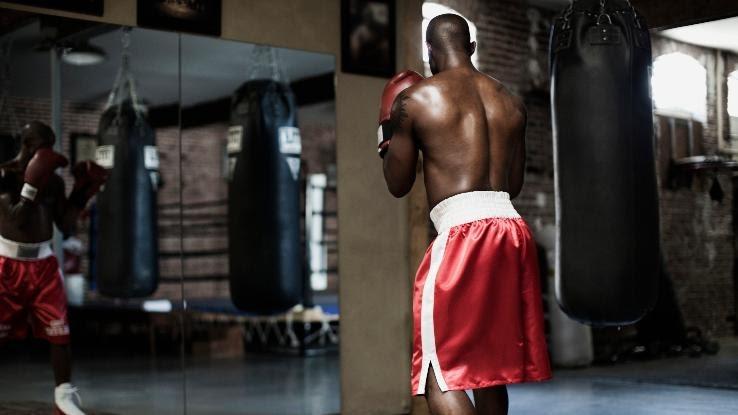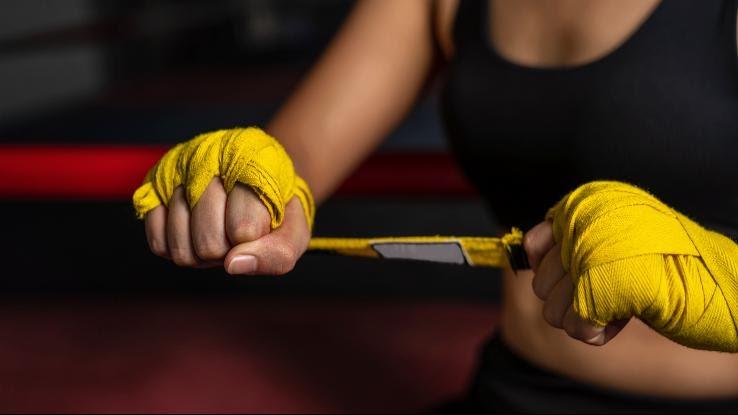
Shadowboxing comes with a lot of perks, including the fact that it’s a great workout you can do from anywhere. As you may have guessed from its name, shadowboxing involves honing your combat skills by “boxing” an imaginary opponent, as opposed to hitting a solid target, like a punching bag. All you need to make this the newest part of your fitness regimen are your fists and a few pointers, which is where our shadowboxing guide comes in.
Why Shadowbox?
Shadowboxing is a great way to make an intense cardio workout a lot more fun. In addition to getting your mind off a grueling workout, it’s also a free form aerobic exercise that doesn’t require any sort of special equipment. Even if you don’t have competitive boxing ambitions, this can be a great way to overcome the monotony of an exercise bike or daily jog.

You’ll quickly discover that shadowboxing tends to be much more engaging than walking on a treadmill for half an hour, namely because it engages both your body and mind. Not only will you get your cardio in, but you’ll also find yourself perfecting each punch, stance and movement. At first glance, it may seem like a good way to tone your arms, but it’s much more full body than that. In fact, the more moves you learn, the more you’ll realize that a lot goes into throwing a solid punch. Plus, it’s easy to incorporate kickboxing and Muay Thai moves for some variety.
As an added bonus, shadowboxing is a great way to work out stress. Even if your opponent is just a figment of your imagination, throwing a solid barrage of punches their way can be immensely satisfying.
Benefits of Shadowboxing for Fighters
If you train in boxing, Muay Thai, or pretty much any other combat sport, you’ll quickly discover that shadowboxing can be very beneficial for your overall training. Instead of concentrating on a bag or moving target, you’ll be able to really pay attention to your form, footwork, and overall technique. It’s also a great way to develop muscle memory, especially when you’re perfecting new moves or trying out combos.

Shadowboxing can also help strengthen your sense of control and balance, both of which tend to be invaluable when sparring. No matter how good they are, every fighter is bound to miss a punch every now and then; a good shadowboxer will have the control to snap their fist back quickly, without letting the momentum of the missed shot throw them off balance.
Additionally, it’s a great way to practice visualization. If you practice combat sports, you probably already know how important it is to train without a sparring partner. While a punching bag is great, it isn’t exactly throwing any new moves your way. But, by imagining an opponent, you can try out different scenarios by practicing combos, dodges, counters and more.
Shadowboxing Basics
Pretty much the only knowledge you’ll need is a familiarity with the six basic boxing punches. These include:

- 1 = left jab
- 2 = right cross
- 3 = left hook
- 4 = right hook
- 5 = left uppercut
- 6 = right uppercut
Pay attention to the numbers assigned to each move: They’re often used as shorthand to describe combos. For example, a 1-2 means you throw a jab-cross combo. You’ll also notice that all the odd numbers refer to left-hand moves while the even numbers refer to right-hand moves.
Some coaches also incorporate 7 — an up shoot — and 8 — an overhand right. And, if you ever see a “b,” that means “body shot.” Nate Bower has plenty of great, free boxing workouts on YouTube, one of which breaks down each of these punches. Be sure and pay attention to the way each part of his body moves, from the way he pivots his hips to how far he extends his shoulder.
Shadowboxing Routines
Another wonderful thing about shadowboxing? You can make up an endless amount of varied routines. In the beginning, it’s often easier to get started with pre-written routines, like this one from IFBB Pro boxer Nicole Wilkins.

If you prefer videos, look no further than YouTube. You’ll find plenty of free shadowboxing workouts for a variety of different experience levels. Some of the best channels to follow include:
- NateBowerFitness: From beginner shadowboxing tutorials to intense shadowboxing workouts, Nate Bower is one of the most popular online fitness instructors YouTube has to offer.
- Precision Striking: Here you’ll find a whole playlist full of shadowboxing workouts. Precision striking also has some really cool interactive boxing videos that let you practice your moves against an on-screen opponent.
- Fran Sands: Fran Sands is also an awesome place for beginners to get started. This channel offers a variety of tips, instructional walkthroughs, and drills.
- Sean Fagan: Keep in mind that shadowboxing is not just unique to boxing. It’s a tool used by a variety of martial arts, including Muay Thai. If you ever want to add some knees and elbows to your moves, check out Sean Fagan, who has a great variety of shadowboxing workouts and tutorials.
One other thing to keep in mind is that shadowboxing and bag routines are interchangeable. So don’t be afraid to check out heavy bag workouts too.
Make Your Own Shadowboxing Routines
Once you get the moves down, it’s easy to make shadowboxing routines of your own. If you ever want to add a little strengthening to your workout routine, you can also look into shadowboxing-specific resistance bands.

If you’re focused on burning calories or losing weight, turn your shadowboxing routine into a high intensity interval training (HIIT) workout. One of the easiest ways to do this? Turn your combos into Tabatas, which are a way to time the duration and intensity of your moves. (In fact, you can find a handy Tabata timer here.) For those who aren’t familiar, the premise of a Tabata workout is that you’ll choose a move or set of moves and do them as follows:
- 20 seconds: Do the move as fast as you can, as hard as you can, as many times as you can within this time frame.
- 10 seconds: Rest — or do the move much more slowly — for the duration.
Repeat this whole process eight times to complete a Tabata. Try a series of different Tabatas back-to-back, change up the time intervals, and more. As always, make sure to check with your doctor before beginning any new fitness routine — and be sure to have plenty of water on hand. Most importantly, don’t forget to be creative and have fun!
Resource Links:
- Intro to Heavy Bag Boxing Punch Numbers via Nate Bower Fitness, YouTube
- “The Beginner’s Guide to Boxing,” via ExpertBoxing.com
Advertiser Disclosure: When you purchase through links on our site, we may earn an affiliate commission.





